Project development approaches provide numerous ways to bring your solution to the market depending on requirements flexibility, project scale, team size, and dependencies. Selecting the right approach will boost the team’s productivity, reduce the risks, and help developers align with your needs and goals.
Each model offers an established process with a set of principles that can be optimal for your particular project and management requirements. Following this process will ensure that the project is developed as planned. Knowing what model to choose will help to define the methods for solution creation, separate tasks, and issue resolution.
In this article, you will learn the peculiarities and common use cases of Waterfall, Incremental and Iterative, Agile, Spiral, Rational Unified Process (RUP), and V-model approaches in project management.
Why software development models are important?
For effective project delivery, tech companies follow their unique Software Development Lifecycle (SDLC), which comprises essential project phases, including planning, execution, and closure. Nowadays, developers emphasize a tailored approach to workflows, using specific software development models that encapsulate these development phases. These models in software engineering serve as a roadmap that encompasses predefined principles, basic flows, and established timelines to ensure a smooth project planning and execution process.
Software development models optimize the overall process and, ultimately, enhance team performance. Each model comes with its unique set of principles to cover specific needs of a particular project. When a company implements a specific model, it aligns the team with consistent working techniques, pace, and vision. The diversity of these models allows companies to choose the one that best suits their unique requirements and team dynamics, leading to improved efficiency and successful project outcomes.
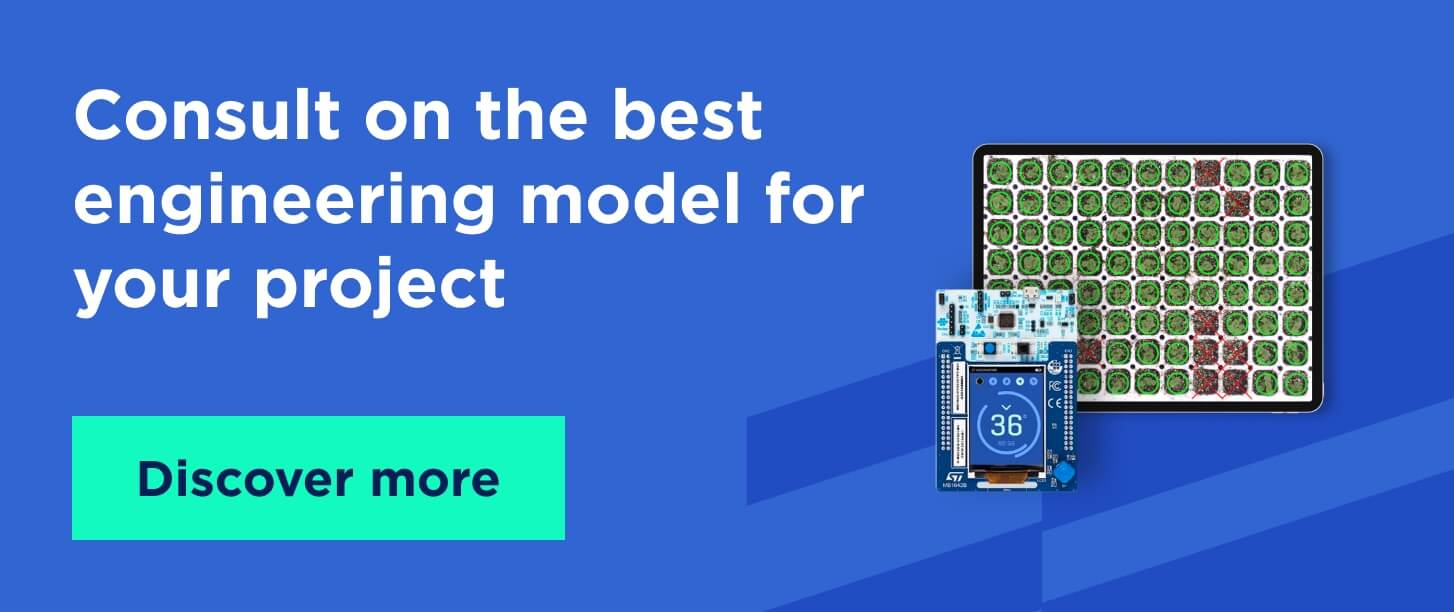
How to choose the right software development model?
Selecting the most suitable SDLC model for your project requires a complex decision-making process. Knowing a clear project goal is crucial in making an informed model choice that aligns with your needs. To navigate this decision effectively, you should consider the following factors:
Project requirements
The accuracy of your model choice depends on the project's predictability and stability. The development team needs to know your project goals, the expected features, and potential timelines. Communicate your expectations to the team so that they can align the requirements with the right development model. Determine if detailed specification updates are necessary after each iterative session and whether your requirements may change during development. On some projects, you can be flexible. However, some require comprehensive preparation before the start since scope changes could lead to a decent amount of code rework. This may lead to additional time and budget inputs if you choose an unsuitable methodology.
Project size
The scale of your project impacts the model choice since the project manager will decide on the team size. Larger projects involve bigger teams, resulting in more complex and detailed management plans. The scale of the project influences the level of coordination and planning required for successful delivery. In most cases, large projects are divided into a few smaller ones.
Project complexity
Evaluate the complexity of the project. If a simple project lacks clear requirements and the product is adaptable, it's not that big of an issue. However, complex projects with uncertain requirements cause frequent changes. Undefined timelines increase uncertainty and unexpected expenses.
Determine whether there is a rigid timeline, meaning that delays should absolutely be avoided, or whether the project allows for more flexibility. You may need to maintain continuous monitoring of the project development process and provide constant feedback to the project manager and team to ensure successful project completion.
Client involvement
During the stakeholder management planning, the PM should define the level of stakeholder interest and power, which will define a potential involvement level. High-power and high-interest stakeholders have the most influence on the decision-making process. Such involvement is needed for communication management and reporting frequency, but mainly for a methodology choice. The project manager will communicate the need for your involvement in the project development process. You may need to consult the team at certain stages if the requirements change. Additionally, clients provide regular feedback to the team to adjust the focus of their work.
Knowledge of technology
Evaluate the team’s familiarity with the project domain, necessary tools, programming languages, and development methods. You may need developers who have industry-specific experience and niche tech skills to create a market-ready product. Software engineering models should align with the team's expertise. This ensures efficient development and problem-solving.
Project resources
Your project manager will help you assess the resources needed to complete the project, including funds and team. Careful resource planning is essential to meet project milestones and objectives.
By analyzing all these factors, project managers can make informed decisions on the software development model that best suits your project's unique requirements and increases the chances of successful and timely completion.
Read also: A Guide to Effective Embedded Development Project Estimation
6 software development models: pros, cons, and use cases
According to Statista, 37 % of the companies prefer using the Agile/Scrum model, 34% apply Kanban, and 26% follow the Waterfall model. Read below to learn more about those and other software development life cycle models.
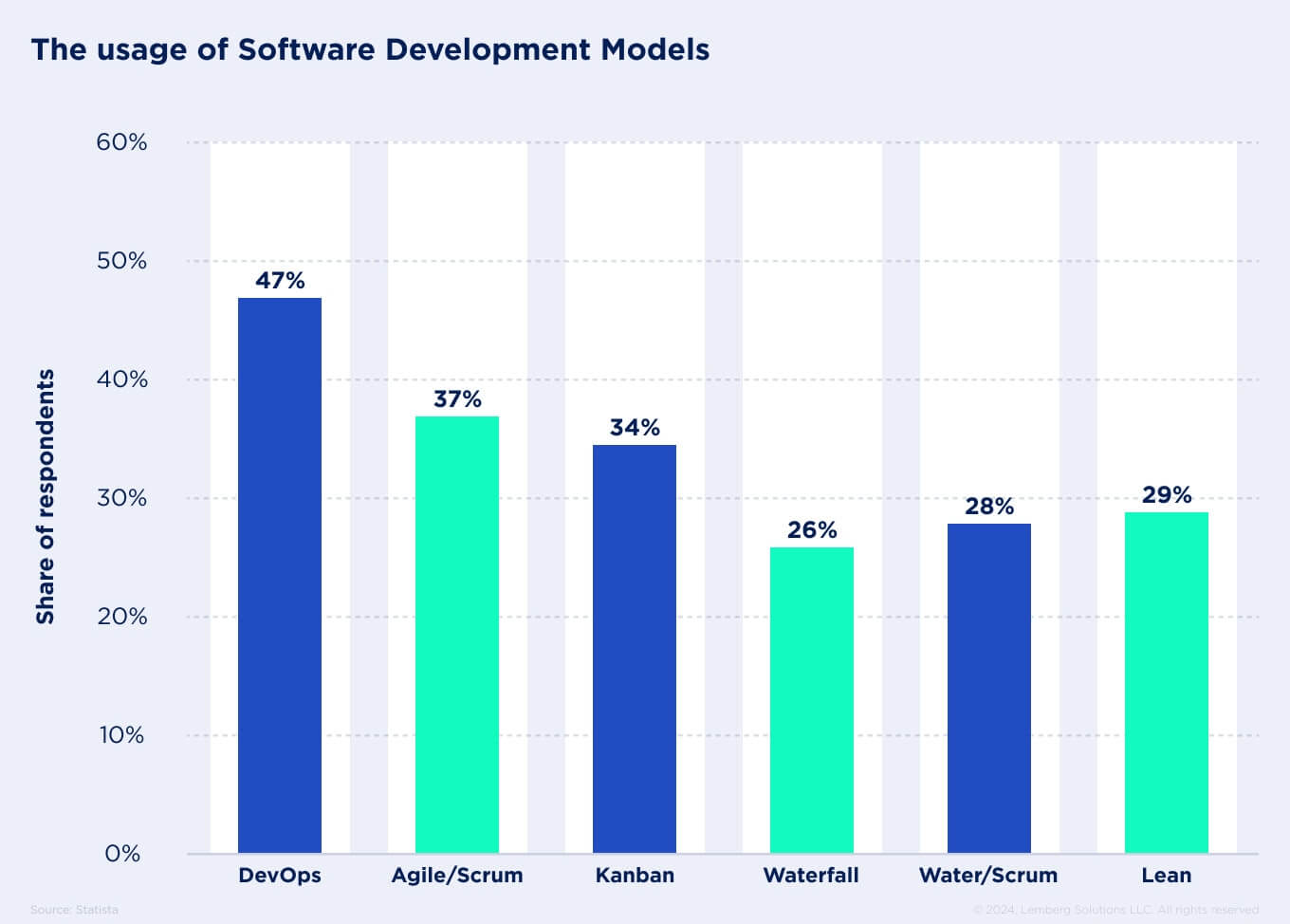
Each project requires different types of software development models to make sure the final results are successful. Learn which software development model suits your project best.
1. Waterfall
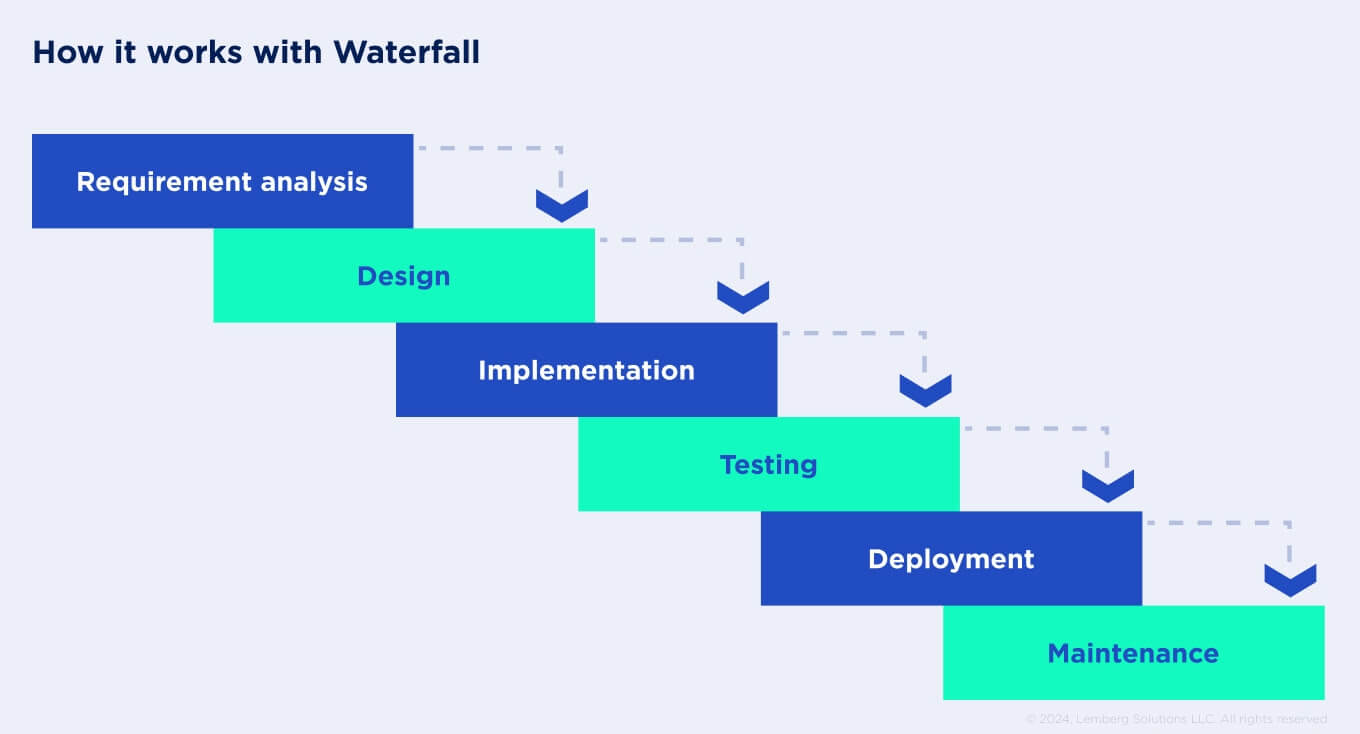
Across all phases of development with the Waterfall methodology, the team follows cascading stages. Every stage includes specific deliverables and comprehensive documentation and ends with a so-called “Gate review” (internal and stakeholder review of the stage deliverables). The beginning of the subsequent stage depends on the completion of the preceding stage. Aspects like the reassessment of software requirements are possible after the planning phase and development start. However, it will require technical documentation updates, project scope change, more effort, and timeline reestimation. As a result, the team will receive a new timeline and budget with an updated scope.
Milestones are usually divided into smaller ones (6-8 weeks) to get customer’s feedback and adjust the next milestone plan. The testing stage is frequently done before each release after every milestone is finished.
Pros:
- Ensures predictable outcomes and estimates of the budget, project scope, and timeline
- Is suitable for complex projects since it requires extensive PM experience to predict risks and timeline
- Clear documentation that can be updated during the project development process
- Usually closed and short cycle
- The team can extend easily at any development stage due to comprehensive technical documentation
Cons:
- Lack of flexibility since each stage relies heavily on previous stages
- Requirements are hard to predict, and the team needs a more flexible approach
- The team has to review and update documentation, as well as the timeline and budget if requirements change
- Testing is not possible until each milestone's final stages
Use cases:
- Complex projects with clear requirements
- Projects that require increased monitoring and set timeline and budget
- Projects that need strict regulations
- Projects with a high number of dependencies and any change that can cause a rework of some functionality
- Projects with maximum effectiveness and minimum communication or management less required
2. Incremental and Iterative models
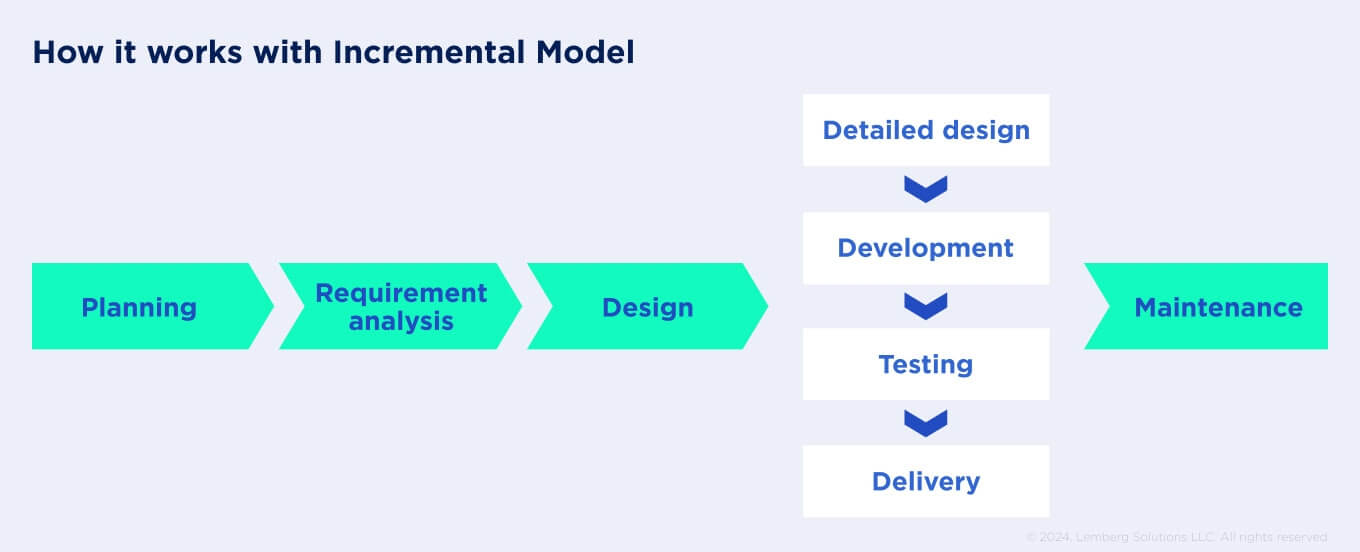
The Incremental model of the development process unfolds through multiple product iterations (increments), requiring a project manager to construct a project structure. Each iteration introduces new software modules while retaining the integrity of previously implemented ones. The team works either in parallel or sequentially. Parallel development speeds up the delivery process, while numerous sequential cycles add up to a project's duration and escalate costs. It happens because every small increment is tested right away. As a result, infrastructure development and the process take more time and budget. That’s why the overall timeline is longer, and the non-development expenses are higher in comparison to cascade models.
In an Iterative development approach, the team modifies software in each iteration, which allows the product to improve and expand gradually. With each iteration connected to the previous one, developers can maintain a coherent software design. This model in software engineering allows for partial software delivery, reducing the need for a comprehensive stakeholder requirements specification right from the start. Small or bigger adjustments to requirements can be integrated and prioritized during project development. Nevertheless, you shouldn’t offer drastic changes if the project follows the Iterative model. Critical requirements like feature sets and technologies must be clearly defined initially to prevent integration challenges or rework since software components are progressively assembled. Notably, this Software Development Life Cycle (SDLC) model often includes high client involvement due to constant feedback needed and potential minor changes in requirements during the development journey.
Pros:
- Incremental and Iterative models ensure adaptability since they allow for seamless modifications, particularly for small-scale projects
- Greater agility since you can change project requirements during the development process
- The team tests the solution at each project stage, which simplifies error detection and bug fixes
- This model allows the most transparency and integrity, ensuring regular reviews of deliverables at every development step
- You can easily track the progress since this model doesn’t necessitate comprehensive documentation
- The risk assessment and minimization process can be included as a separate stage
- The model facilitates testing and integration of valuable user feedback, contributing to the refinement of the end product before its finalization
- Easy process for the team as they’re dealing with short iterations
Cons:
- Providing major requirements is a must, which helps to avoid any issues during the development process
- Despite the advantages, Incremental models do not match the flexibility inherent to an Iterative approach
- Iterative requires more project management
- Uncertainty, as a side effect of flexibility, could be fatiguing for some engineers
Use cases:
- Large-scale projects (e.g., enterprise applications based on microservices)
- Startups and constantly growing products
- Highly flexible technologies Web or mobile
- PoC-type of products because of ease of scalability in the future
3. Agile Models
Agile methodology revolves around constant communication, early end-user feedback, and iterative development. The approaches within Agile (Scrum, Extreme Programming (XP), Kanban, DSDM, FDD, TDD, Lean, SAFe) prioritize swift delivery of working app components. As a result, the development team reduces the focus on documentation, such as architecture and in-depth requirement specifications. Instead, the team is more involved in software testing activities. Agile ensures a fast development process with more time spent on testing and bug fixes.
Agile promotes close collaboration between the client and the team. After the iteration has been implemented, you can review the development progress and reassess task priorities for subsequent iterations. Such an approach helps to enhance ROI while sticking to end-user needs and your business goals.
Agile models in software development are known for frequent releases, which foster continuous software polishing through regular updates, modifications, and feature enhancements. With Agile, clients receive a solution that matches users' changing needs. It allows for project growth. However, the approach doesn’t pay much attention to detailed planning, which reduces the accuracy of project estimates.
Scrum
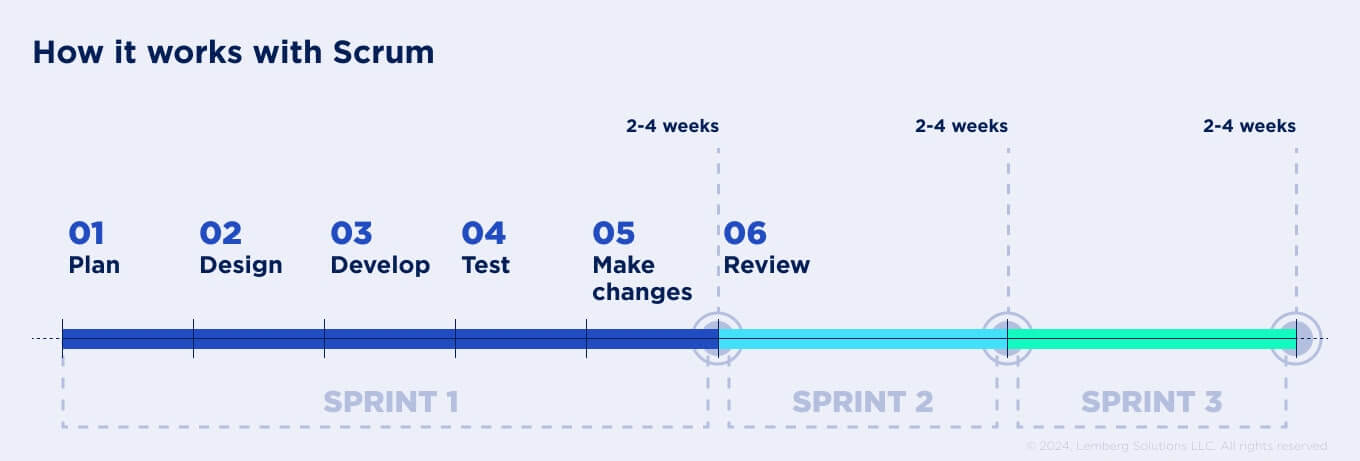
Agile admirers usually choose Scrum as a main project management approach. The team thoroughly plans and assesses each sprint. Usually, sprint duration takes 2 to 4 weeks. However, using Scrum, the team cannot change requirements for the sprint. The teams are usually self-managed with specific roles assigned.
Pros:
- Large projects are split into easily controlled sprints
- Ongoing deliverables are tested after each sprint
- Suitable for projects with tight deadlines
- Ensures development transparency for the team
- Allows for adjustment from stakeholders and clients
Cons:
- A project’s scope frequently increases due to the absence of a specific completion date
- Doesn’t work well for large teams
- Requires senior experience from the team members
Use cases:
- Flexible projects with evolving requirements
- Projects that depend on a collaborative team
Extreme Programming (XP)
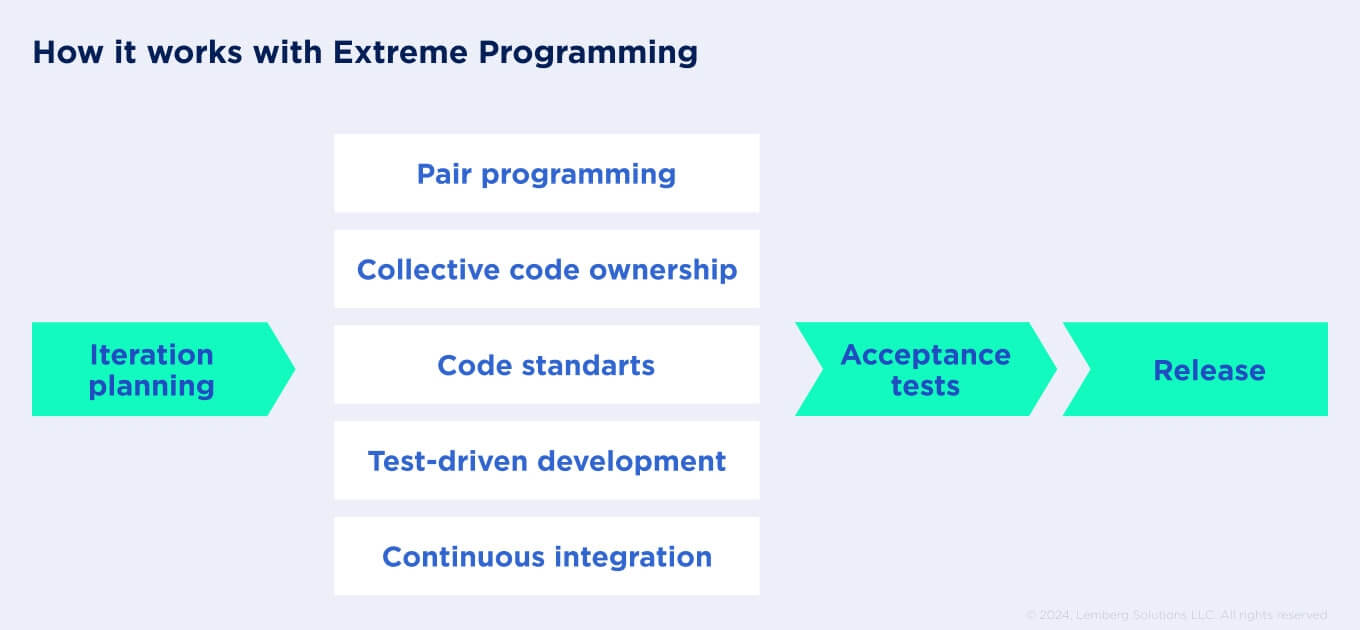
An XP approach includes 1-2 week sprints. The team can implement changes even if the sprint has already started. However, constant changes can impede the successful delivery of a solution. That’s why the team should pay attention to software testing, CI/CD practices, and simple software design.
Pros:
- Allows for close cooperation with the client
- Eliminates the need for unnecessary development
- Ensures stable results due to continuous testing
- Provides flexibility for the teams, eliminating any overtime
- Allows for last-minute changes
Cons:
- Requires additional work in terms of frequent testing and CI
- It is necessary for the client to be involved in the process
- Requires a lot of time
- Necessitates version management
Use cases:
- Projects with frequent requirement changes
- Projects requiring a small development team
- Projects using technologies that allow for unit and functional testing
Kanban
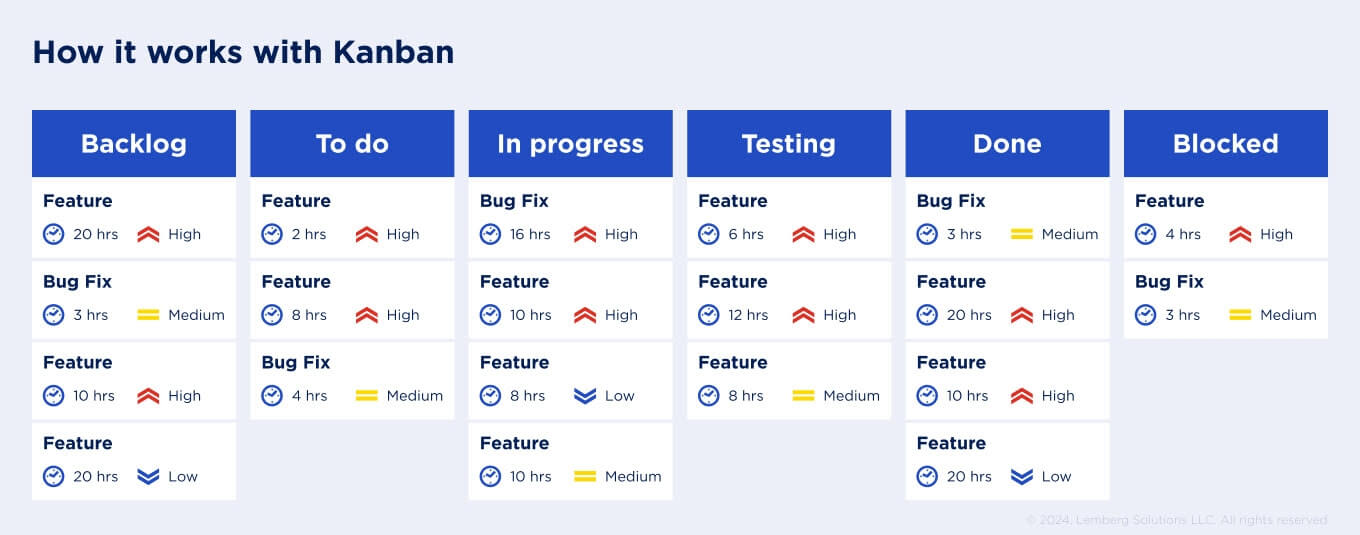
Kanban doesn’t focus on well-defined iterations. Even if there are any, Kanban requires to make them short, in the form of daily sprints. The primary focus is on the project visualization. Utilizing tools like the Kanban Board, the team creates a visual depiction of project progress, including tasks, project roles, and activities. Kanban increases project transparency and allows for more effective prioritization. The model also enables changes at any sprint. Continuous communication with the client enables them to review work results and set up regular meetings with the team.
Pros:
- Easy to implement any changes and fix the issues
- The team doesn’t rely on a rigid plan or detailed project requirements since Agile approach allows for updates
- The development phase is usually short
- Teams can easily organize and move through the stages
- Early user feedback allows to implement needed changes as soon as possible and adjust the product to the market demand
- Better alignment with client expectations since they are more involved in the development process
Cons:
- Hard to estimate the final project budget
- Hard to set strict timelines
- Documentation requires more attention from the team
- The final product can be hard to assemble
- Difficult to measure the progress due to the floating KPIs
Use cases:
- Ideal for startups since the early feedback from end users is a must
- Turnkey projects with custom features and lack of precise requirements
- Projects that can be divided into several development phases
4. Spiral Model
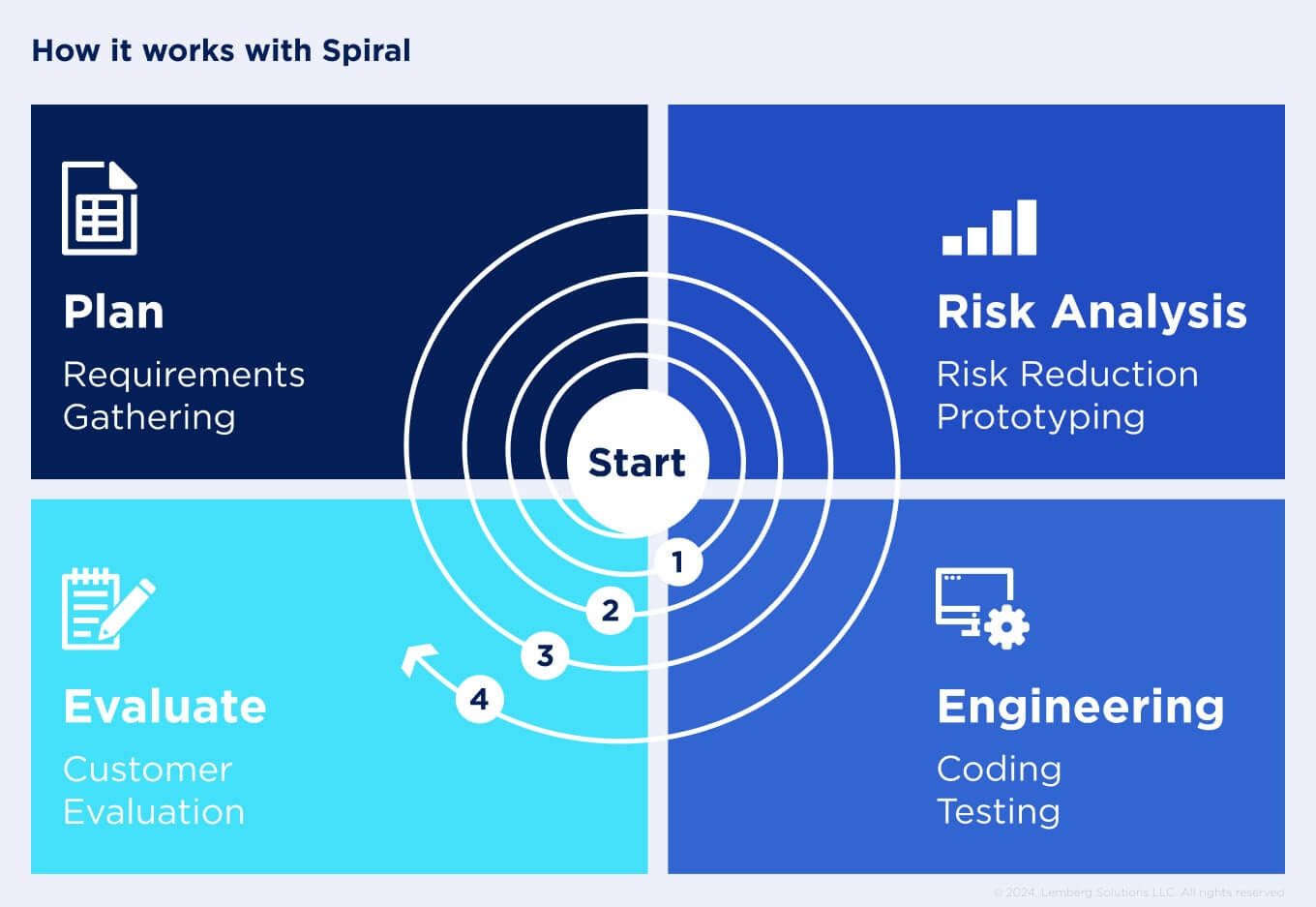
The Spiral model revolves around comprehensive risk assessment, making it essential to involve individuals who can effectively evaluate risks and predict the best project development. With a standard iteration of 6 months, the Spiral approach encompasses in-depth planning, risk assessment, prototype development, and analysis of the preceding iteration results. However, the Spiral model is also associated with extended project timelines. The Spiral model requires constant client involvement in the research and review stages of each iteration.
Pros:
- The Spiral model ensures the early production of software
- Risk assessment and issue prevention are at the core of the Spiral model
- Allows for requirement modifications at the later stages of product development
- Clients can participate in project management early on and provide regular feedbacks
- Strict rules for documentation
Cons:
- The approach setup is complex
- Requires experts with specific risk assessment skills
- Timelines are hard to predict
- Doesn’t work for low-risk projects
Use cases:
- High-risk projects with unset or innovative business requirements
- Large and complicated projects
- Innovative features development and implementation of new functionality into the product
5. Rational Unified Process (RUP)
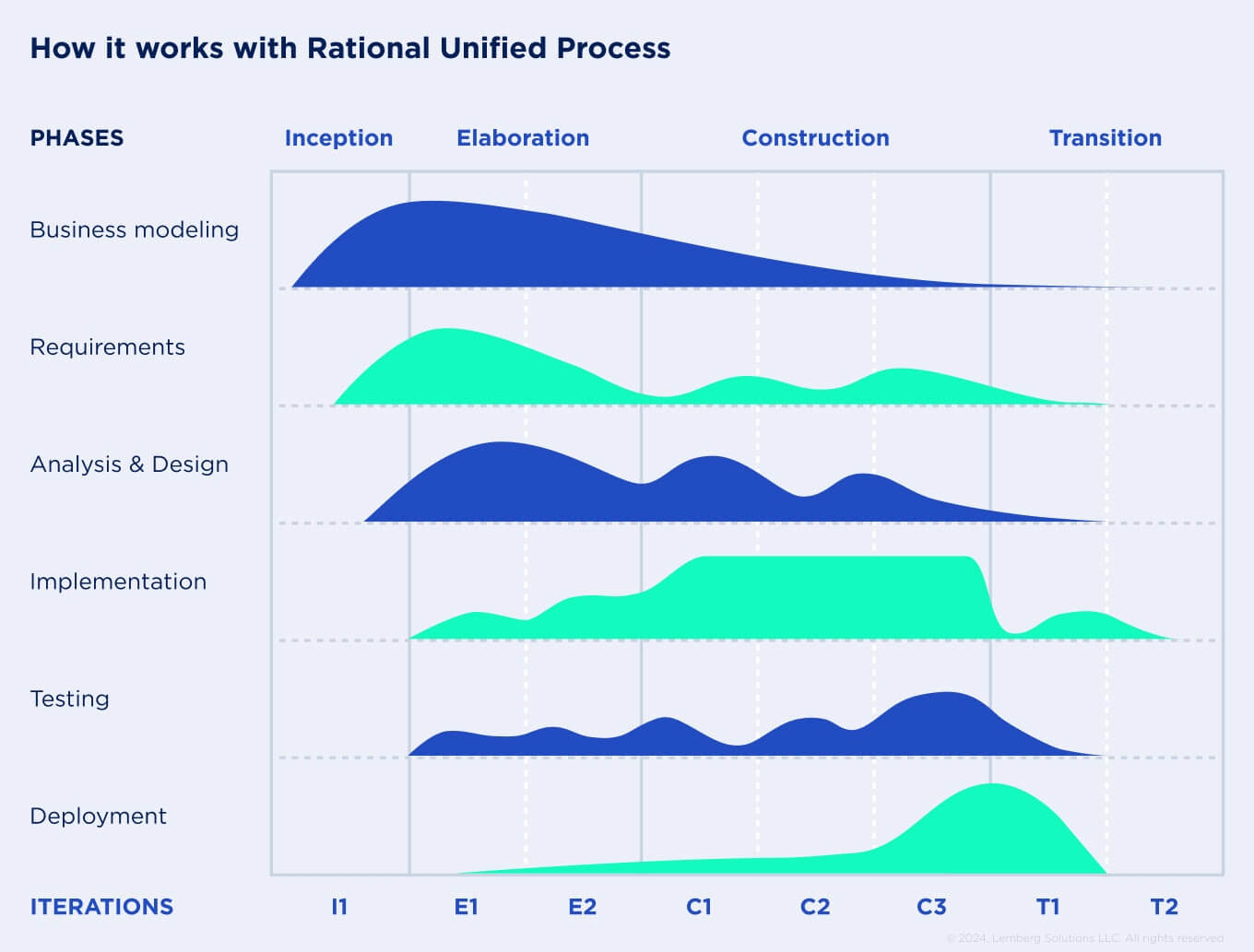
The RUP model is a hybrid approach using the elements of iterative and linear frameworks. With this model, developers follow four stages, such as inception, development, construction, and deployment. Each phase, except for Inception, typically requires several iterations.
The team applies the RUP approach to create the products notable for stability and flexibility. However, RUP won’t help with quick results in the same way as Agile models. Client involvement and documentation rules depend on the project requirements.
Pros:
- Enables cross-functional cooperation
- Can be used for fixed workflows
- Ensures flexibility since changes can be introduced throughout the project
- Simplicity in project management
Cons:
- Unsuitable for complex dependencies
- Requires agile management approach
- Includes business model development within the project, which adds mode people to the team
Use cases:
- Large projects that require risk management
- Startup products, especially for idea validation
6. V-model
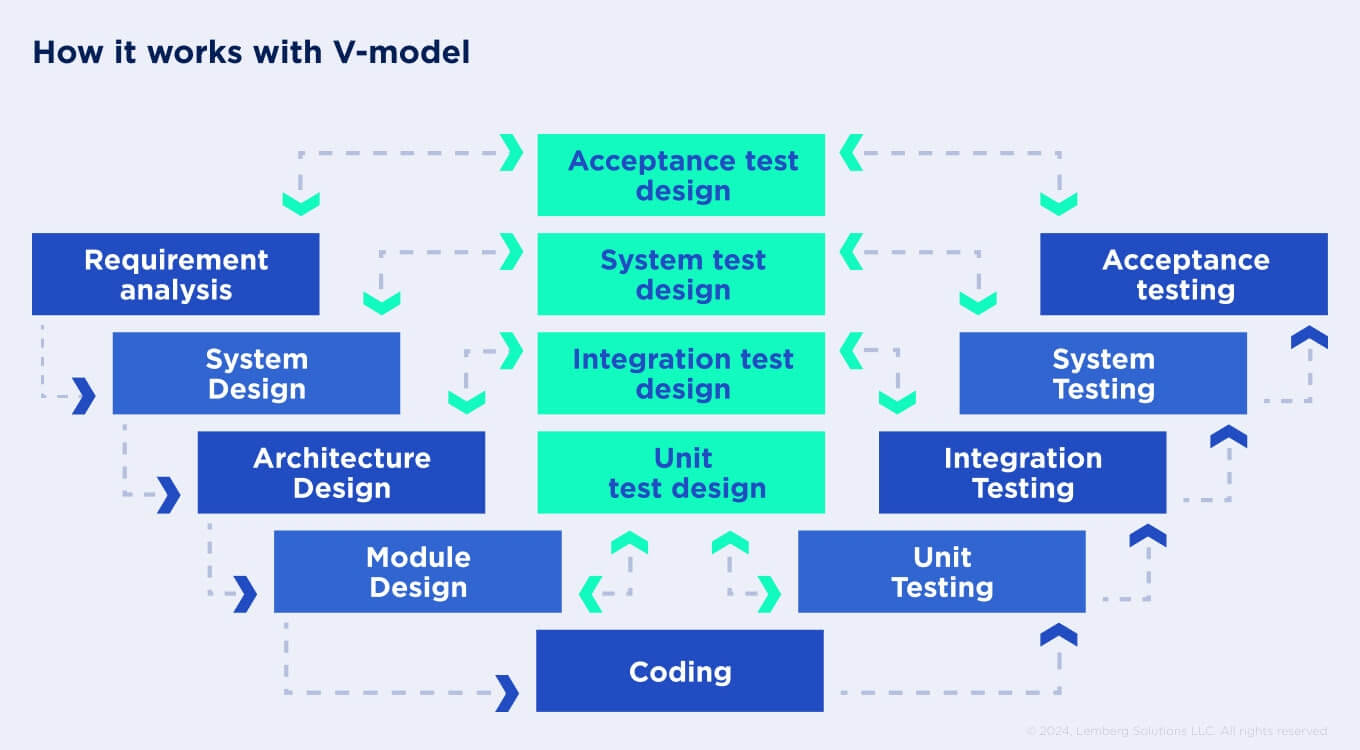
The V-model helps to organize the project in a sequential manner, following the “V” shape of development stages. First, the team needs to do requirement elicitation and analysis. Second, system architecture design and software architecture design, along with specifications for each feature. In parallel, QA team adds acceptance criteria to stakeholder requirements and verification criteria to technical documentation. Both of them are integrated into test cases, ensuring traceability and consistency.
V-model is also known as the Verification and Validation Model and is based on the Waterfall model. This model emphasizes bidirectional traceability from initial stakeholder requirements to test cases and implemented features, which ensures that the team implements precisely what the stakeholder requests. In this approach, each developmental stage incorporates product unit testing during the first phase, qualification testing of the stand-alone features, integration testing, and so on. The process entails completing a stage, testing the solution, and proceeding to the next stage, as well as updating an architecture design and adding test cases.
Pros:
- Frequent testing ensures a high chance of project success
- Includes clear requirements work to set a basis for next steps (like architecture)
- Includes integration phase and integration testing as a crucial part of SDLC not considered in other frameworks
- Provides the possibility for almost any SPICE inclusion, which makes it perfect for automotive or medical projects
Cons:
- Lack of flexibility
- No possibility of creating an early prototype
- Higher level of complexity of processes with the possibility of comprehensive configuration management
Use cases:
- Projects with strict requirements and deadlines (e.g., automotive, medical software)
- Complex and large projects where each requirement should be meticulously traced and executed
- Highly regulated industries which require very precise planning and execution in accordance with ISO standards or stakeholder’s requirements
Read also: A Guide to a Typical Tech Audit Process for Embedded Projects
How our PMs ensure project success through SDLC framework combination
The combination of incremental and iterative frameworks filled with innovative approaches created Agile practices. Repeated processes and the need for optimization and efficiency within a limited budget created a combination of lean and Six Sigma.
Essentially, project managers apply framework combinations. For instance, DevOps, CI, Code style, GitFlow, and pair programming originate from Extreme programming methodology. Jira board is an extension of Kanban, which we can use as a management framework or work breakdown structure (WBS). With WBS, PMs can ensure proper task prioritization.
PMs often decide when to use certain resources. They plan the workload of different teams to make sure each team joins the development process on time. To make this planning work, PMs apply a Critical Path Method (concept and formula).
Below, we make some framework combination examples for complex projects in Web/mobile (Agile-based) and IoT/embedded domains (Waterfall-based).
Framework combination for web/mobile project
Project description:
- We have 2 native mobile apps with web applications connected to a fleet of simple smartwatch apps in scope
- A project has a long feature list, only 15-20% of which have a sufficient description and are clear
- Stakeholders are constantly working on market research (trends, competitors, focus groups, and customer development
- Stakeholders calculate unit economy and financial modeling of each feature attribute, which frequently changes the project scope
Project planning:
Since a PM has to adjust to rapidly changing requirements and will work with fairly flexible technologies, their planning can be flexible too (if the opposite isn’t required by stakeholders). A PM can choose SCRUM methodology with the elements of XP for planning. This way, they will create a high-level roadmap with a backlog (SCRUM), in which they should include Sprint 0 for system architecture design to keep the system as a whole during the project (XP). A PM should determine which features are the most valuable and should be developed in sequence and which can be developed simultaneously. They can use some principles of CPM and Waterfall (or FDD) or make a simple Gantt chart to visualize critical work and resource planning. If a client doesn’t need a 2-3 week iteration for each review, a project manager can make a release plan based on features chosen for each Milestone (XP).
Project execution:
The team for the project would be large (5-15 members). That’s why a PM would need to set internal rules with definitions of work done, communication, code style, QA approach, specific CI, and technical documentation maintenance. To make this work, a PM can take some valuable concepts of V-model and SPICE frameworks (configuration management, technical documentation work, SW units integration into components). Additionally, a PM can use XP practices, along with SCRUM and feature-driven development on integration and configuration management. Lastly, a PM can use Kanban principles along with visual representation for work breakdown structure (keeping only a few tasks “In Progress” for engineers).
Project closure:
Every framework requires deliverables presentation, technical support, production issues fixed (hotfixes), and used libraries, APIs, and services updated.
Framework combination for IoT/embedded project
Project description:
A PM would have to use a completely different approach on an IoT/embedded project (consumer electronics or other industry-specific products like automotive or medical devices). However, they still can use some Agile principles and have retrospective meetings after each 4-month milestone completion.
Project planning:
As we have a highly regulated industry and a more complex product that contains numerous dependencies and conditions, the requirements should be clearly defined. Also, a PM should know which ISO standards to comply with, a defined budget, and, in most cases, an exact timeline before certification testing starts (because a lab with needed equipment is rented in advance). In this case, the team would do requirement solicitation, elicitation, and analysis only after drawing a system architecture and selecting components (safety goals and requirements, HARA, and safety case done in parallel if a team needs to comply with complex regulations). A PM should plan using Waterfall with CPM elements, including activities described in V-Model, SPICE, and ISO process requirements (if we have one to comply with).
Project execution:
Our project example requires strict planning and a team developing one part after another. Each project part heavily depends on a previous part done by another team. A PM should do a Gate review and check all the documents and deliverables before starting the next Milestone. In this case, a PM can use model-based development following the V-model principles. This approach will allow a PM to have a technically described, implemented, and auto-tested unit. Moreover, it ensures that integration and qualification/integration testing are done. If a PM has a few teams, each unit is developed and tested by different teams, which are managed using SAFe or some other scaled-agile framework.
Project closure:
With such projects, software development and code freeze start two phases before all electronics and mechanical work is done and certification testing starts. Some engineers should stay on a project even after their work is done since they will support further development.
How we can help
Making a project work through all the development phases can be a challenging task, especially for large-scale and complex solutions. However, our certified project managers have hands-on experience with projects of different scales and industry focus. We can help you with end-to-end solution development, undertaking your project from an initial stage (when we will collect and analyze your requirements) and leading it right to the market launch. Our project managers will also help you with the support & maintenance stage, directing the team to the desirable results.
Moreover, our project managers follow international regulations for data security and quality management since Lemberg Solutions has received ISO 9001:2015 and ISO 27001:2013 certifications.
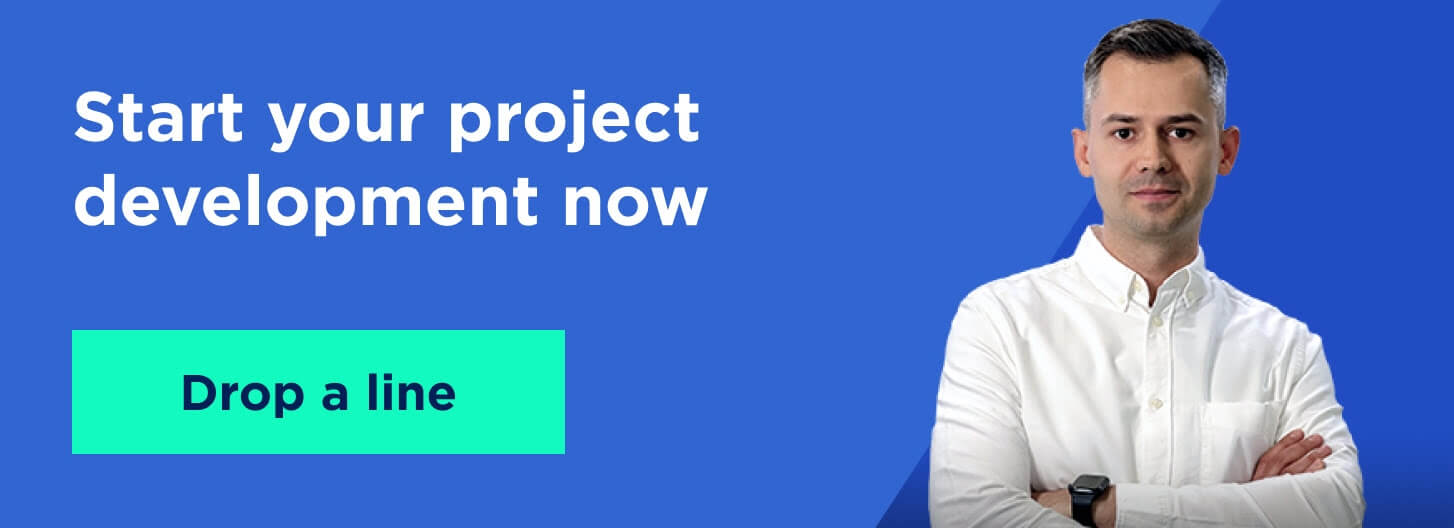
Takeaway
Software development models, if chosen wisely, can help your project thrive. A project manager of your team will help you choose the right approach and guide the team through all project stages. Building the workflow around needed approaches will reduce risks, increase team productivity, and accelerate time-to-market.
If you need help building your solution, don’t hesitate to contact us!


